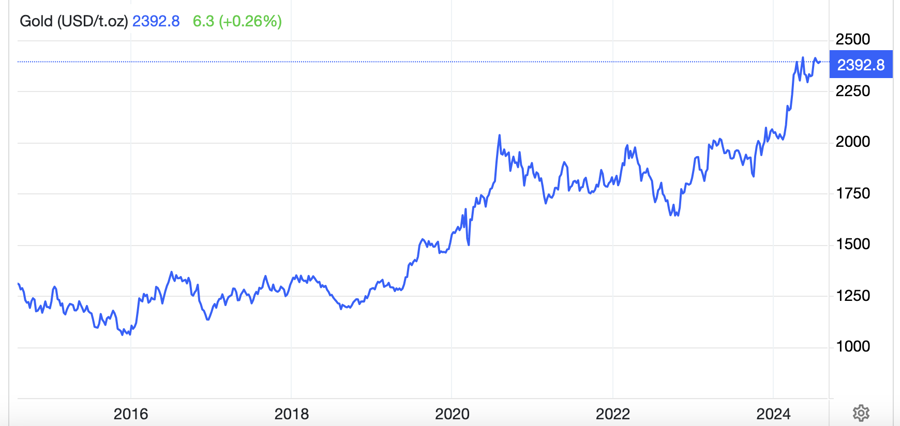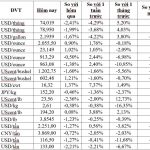Gold prices could be volatile this week as a series of major central bank monetary policy meetings and key US economic data are set to be released.
As of 9 a.m. Vietnam time, spot gold prices in Asian markets stood at $2,392.20 per ounce, up $5.10 per ounce from the previous session’s close in New York, equivalent to a 0.21% increase, according to Kitco News data. Converted at Vietcombank’s selling rate, this price is equivalent to about VND 73.4 million per tael, an increase of VND 200,000 per tael from the previous week.
Earlier, gold prices briefly touched $2,403 per ounce. Last week’s sell-off pushed gold prices below the key $2,400 per ounce level.
Global investors are cautious ahead of the monetary policy meetings of central banks, including the Bank of Japan (BOJ) on Wednesday, the US Federal Reserve (Fed) on Tuesday and Wednesday, and the Bank of England (BOE) on Thursday.
It is predicted that the BOJ may raise interest rates, while the Fed is expected to keep rates unchanged but could signal a rate cut in September. The BOE, on the other hand, is likely to initiate its first rate cut after a period of aggressive tightening to curb inflation.
Analysts suggest that any actions or signals from these meetings that deviate from market expectations could cause volatility in financial markets. In particular, the USD exchange rate against other major currencies may fluctuate significantly, impacting gold prices.
Additionally, on Friday, the US Department of Labor will release the overall employment report for June, which could influence the Fed’s decision to cut rates in the September meeting.
Currently, gold prices are supported by the possibility of the Fed easing monetary policy in the fall. Data from CME Group’s FedWatch Tool indicates that the market is betting on an almost 86% chance of a Fed rate cut in September, with a reduction of 0.25 percentage points.
Some experts caution investors against betting too heavily on a Fed rate cut, especially after a US Commerce Department report last week showed that the economy grew at a faster-than-expected 2.8% annual rate in the second quarter.
“The market has gone too far in predicting a Fed rate cut. Before the GDP report, the market was pricing assets as if the Fed would cut rates by half a percentage point in September,” said Marc Chandler, a strategist at Bannockburn Forex, in an interview with Reuters.
In an article published by Bloomberg on Wednesday last week, former New York Fed president Bill Dudley argued that the Fed should cut rates immediately in the July meeting as employment data has shown signs of weakening.
However, Chandler opined, “The GDP data shows that the Fed is not in such an emergency situation.”
The US Dollar Index, which measures the strength of the USD against a basket of six other major currencies, opened the week on a weaker note, providing some support for gold prices. As of 10 a.m. Vietnam time, the index had decreased by 0.15% from the previous US session, trading at 104.16 points.

George Milling-Stanley, chief strategist at State Street Global Advisors, predicted that gold prices would maintain their upward trend as the door is open for a Fed rate cut in September. “The Fed will cut rates in September and initiate a new easing cycle. This will cause the dollar to depreciate and support gold prices,” he stated.
In contrast, Sunshine Profits CEO Przemyslaw Radomski argued that gold prices may have peaked, even with a potential Fed rate cut in September, suggesting that gold’s trajectory could be sideways or downward rather than reaching new highs.
In a recent report, Radomski emphasized that while the market expects gold prices to rise when the Fed cuts rates, the opposite could also occur.
“It’s not going to be as simple as people think. Real interest rates (nominal rates minus inflation) are what really govern gold. Moreover, gold prices have risen significantly even before the Fed cuts rates, meaning that the effect of rate cuts has already been priced into gold,” the CEO wrote in the report.
Radomski even suggested that gold prices currently reflect expectations of three Fed rate cuts this year, while the Fed may only cut rates once or twice.
Weekend Ending Sees Significant Gold SJC Price Drop
After surging to nearly 79 million dong per tael on February 2nd, the price of SJC gold is now plummeting towards the 78 million dong per tael mark this weekend.







































